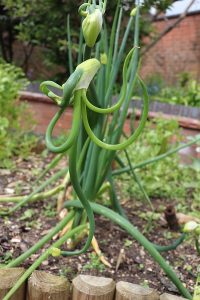
Egyptian walking onions do not come from Egypt. It is not clear where they do originate from, but they can be found all around the world. They get the name “walking” because of the way they spread themselves across the garden. During the summer, the stalks form bulbils which are like tiny onion sets on their tips. This can be a cluster of 5-8. The bulbils then start to grow, sending out their own shoots. The weight of these makes the parent stalk bend down to the ground, where the bulbils can take root. Some bulbils start sending out their own bulbils in a matter of weeks, before they even reach the ground. Thus the plants move around the garden. They look quite alien at times and are a good talking point for visitors.
You can, of course, remove the bulbils at any stage and plant them where you want them to grow, or pot them up for later. They are edible as well, although I have not tried them, preferring to propogate them and increase my stock instead. I do pick the leaves through the year. They are similar to spring onions, without the white bulb, and are good as a garnish to oriental soups or to add a bit of a bite to salads. The plants send out leaves from spring to autumn, giving you a long period in which to harvest them.
The parent bulbs bulk up over time and after a year are likely to divide up into multiple bulbs, rather like a shallot. You can dig up the bulbs for eating. While they are not as big as a regular onion, they store well. You can use as a substitute for regular onions in cooking.
These plants are very tough and every one of my bubils grew into a new plant. I find it strange that they are not better known given all their positive attributes. In my opinion, everyone needs an Egyptian Walking Onion in their garden!
